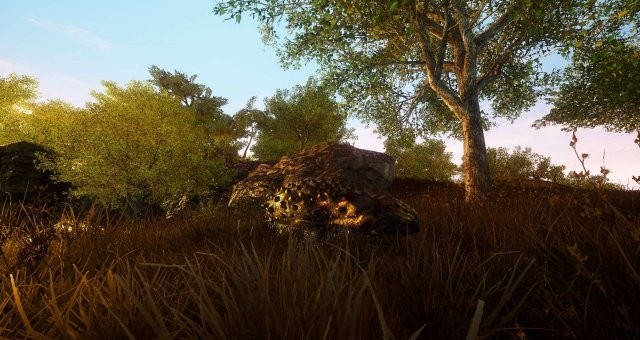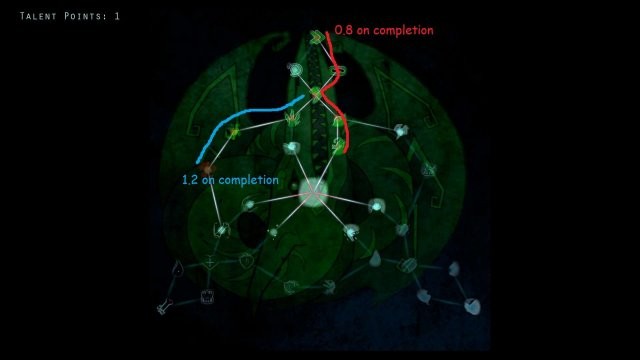
Als Spieler mit über zweitausend Stunden kleiner Herden- und Solo-Para fühle ich mich, als wäre ich der richtige Mann, um Ihnen einige Tipps zu geben, wie Sie ein effektiver Para-Spieler werden können, nicht nur für sich selbst, sondern auch für Ihre Herde , unabhängig von seiner Größe.
Vollständige Informationen zu Parasaurolophus
Anfang
Als Parasaurolophus ist es wichtig, die grundlegenden Waffen und Strategien zu kennen, die Ihnen zur Verfügung stehen. Als großer Pflanzenfresser, der auf Migration angewiesen ist, um gefährlichen Fleischfressern auszuweichen, sollten Sie darauf achten, nicht zu lange an einem Ort zu bleiben, da dies große Fleischfresser wie Tyrannosaurus und Acrocanthosarus anzieht, die eine Bedrohung für Parasaurolophus darstellen, selbst wenn Sie sich in einem befinden große Herde.
Ich kann generell raten, dass Sie sich mit anderen Pflanzenfressern Ihrer Größe zusammenschließen, wie anderen Parasauriern oder kleineren Pflanzenfressern wie Pachycephalosaurus. Es mag verlockend sein, Apatosaurus, den großen Sauropoden, in der Nähe anzubauen, aber auf lange Sicht wird dies viele Fleischfresser anziehen, die nach einer Mahlzeit suchen, und Sie wahrscheinlich in Gefahr bringen. Ich kann auch davon abraten, mit Spielern zu hüten, die keinen soliden Plan für die Ankunft von Fleischfressern haben, da dies dazu führen kann, dass Sie sich in einer exponierten Position befinden.
Als Parasaurier stehen Ihnen vier mächtige und etwas einzigartige Fähigkeiten zur Verfügung, die erste ist Ihr Alarmruf, der durch Ihre Fähigkeitstaste (normalerweise standardmäßig auf Z oder Q) aktiviert wird. Der Alarmruf hebt jeden Fleischfresser in Reichweite hervor, auf den Sie zielen Cursor, um Ihren Herdenkameraden einen Hinweis zu geben, dass Gefahr in der Nähe ist. Ich rate jedoch davon ab, diese Fähigkeit zu spammen, da Sie dadurch zu einem Ziel werden. Es ist am klügsten, sie ein- oder zweimal zu verwenden, um die Aufmerksamkeit Ihrer Herde zu erregen, anstatt während eines bereits aktiven Kampfes, da dies den Fähigkeitspool verschwendet, der für Sie verwendet werden könnte zweite Fähigkeit, das Stampfen.
Das Stampfen ist der stärkste Angriff von Parasaurolophus, obwohl es Ihre Bewegung für die Dauer stoppt, während Sie beim Stampfen keine Punkte in der Reihe platziert haben. Der Stampfer verursacht bei einem erfolgreichen Treffer auf den Körper eines Fleischfressers eine angemessene Menge an Schaden und Verletzungen, selbst ohne Krafttalente. Es nimmt jedoch einen erheblichen Teil Ihres Fähigkeitspools ein und muss verwendet werden, wenn Sie sicher sind, dass Sie den Treffer landen werden, um Situationen zu vermeiden, in denen Sie keinen Fähigkeitspool mehr übrig haben und ein Fleischfresser in Ihr Gesicht beißt.
Die dritte Fähigkeit ist bewegungsorientiert, das Drücken der Ducken-Taste (standardmäßig Kontrolle) lässt Parasaurolophus auf allen vier Beinen laufen. In dieser Position ist Parasaurolophus unter den meisten Umständen langsamer, außer wenn es bergauf geht, wo der Parasaurolophus im Spiel am schnellsten bergauf geht. Parasaurolophus kann in dieser Position auch sprinten und ist damit der einzige Dino, der in der Hocke sprinten kann.
Ihre letzte Fähigkeit ist die Fähigkeit, während der Bewegung zu grasen, indem Sie die Interaktionstaste (standardmäßig E) gedrückt halten und sich in eine beliebige Richtung bewegen, damit Ihr Parasaurolophus automatisch alle ihm zur Verfügung stehenden Pflanzen frisst, während er geht. Wie der Ducker kannst du dabei auch sprinten, was den Para zum ultimativen Wander-Pflanzenfresser macht.
Lassen Sie uns mit diesen Fähigkeiten im Hinterkopf zu den Talentpunkt-Builds kommen.
Anfänger Parasaurolophus – Geschwindigkeit
Wenn Sie ein neuer Spieler sind, möchten Sie im Allgemeinen nicht sofort in den Kampf einsteigen. Für Ihre ersten paar Para-Spiele kann ich Speed Para empfehlen, indem Sie trittsichere und starke Beine aufbauen, um Ihre bereits erstaunlichen Bewegungsgeschwindigkeiten bergauf und bergab zu stärken, und dann durch Ausdauerpool und flinken Fuß in Geschwindigkeit, Ausdauerpool, damit Sie längere Zeit und flink laufen können footed to give you added turn rate, which will be useful against Megalosaurus, a fast medium sized carnivore that can be a large threat to newer Parasaurolophus players. Speed increase will help get you away from dangerous carnivores such as Acrocanthosaurus and Tyrannosaurus.
By the time you finish these talents you will already be 0.8, so close to 1.0! However there are more talents you can take as you grow, such as going into sneaky to get both clotting and turn while stomp, sneaky being incredibly useful for avoiding Tyrannosaurus and turn while stomp making it easier to hit those pesky Megalosaurus players with your stomp, which can easily cripple a Megalosaurus and allow you to escape with little issue, as the injury damage you inflict should you hit their body with the stomp should easily make the Megalosaurus slower than you.
Attached to this section is a visual guide.

Safe Parasaurolophus – Power
While speed Parasaurolophus is good for new players, you will quickly notice you lack the raw strength to deal with more than one Megalosaurus attacker at a time and will struggle or entirely die when fighting Acrocanthosaurus and Tyrannosaurus. This build fixes two of these problems (although, still be weary about engaging large packs and avoid Acrocanthosaurus fights where possible), unfortunately Tyrannosarus is simply too powerful to fight one on one as a Parasaurolophus, but you will be able to avoid them if you pay attention while playing this build. The issue with this build is primarily the vulnerability you have while under 0.8, due to the lack of speed to get away from things, however past 0.8 and well into 1.2 you will find that you can battle one or two Megalosaurus players at a time, almost certainly beating a Megalosaurus in one on one combat.
Firstly you want to specialise into ability pool and strong bones, ability pool to increase the amount of times you can use the strong Parasaurolophus stomp (which is heavily improved by this build) and strong bones to reduce the amount of injury damage taken (and as a result, speed lost) when in combat. You then want to go through healthpool increase, a powerful talent for the already decently tanky Parasaurolophus, towards damage increase and bruiser, Damage increase giving the Parasaurolophus stomp a respectable bonus to its base damage and Bruiser causing you, when it’s maxed out, to deal injury even on tail hits, meaning if you miss a body shot with a stomp, you still deal that much needed injury damage!
By the time you max out bruiser, however, you will be 0.8, after which you should start specialising into clotting, to combat Acrocanthosarus’ bleed, a powerful debuff which stops you from healing, Turn while stomp, which allows you to more easily aim your now debilitating stomp and sneaky, which allows you to avoid Tyrannosaurus a lot easier.
The Talent build is attached below.

General Combat Tips And Tricks
For either build as a Parasaurolophus you should never turn and run if your predator is already on your tail, as they can easily remain on your tail and nibble away at it, slowly but surely reducing your health to zero. Rather, if it looks like a fight cannot be avoided attempt to get on the rear of your attacker, headbutting them with the primary attack key (Default:Left click) and hopefully stacking up injury to easily land a stomp. Make sure not to waste ability by using the Alarm call, your herd will already know you are being attacked by the dinosaur pain sounds.
Rather, you should headbutt them a few times until you think you can land a stomp, at which point you should immediately try to, as on either build it is your most powerful weapon. Always however try to remain behind your predator, the Parasaurolophus is tanky, but not against a Tyrannosaurus or Acrocanthosaurus bite. This tactic primarily works for Megalo and Acrocanthosaurus, but in the unfortunate event you are forced to fight a Tyrannosaurus in one on one combat, sticking to the headbutt and avoiding the front end of the Tyrannosaurus is your best bet.
Against Velociraptors, attempting to headbutt them when they leap at you is a good idea, so is suddenly stopping if they are riding your ankles, and using a stomp. Either way you will instantly kill the Velociraptor under most circumstances.
You will find that once you kill a few carnivores (your kills will likely mostly be Megalosaurus and Velociraptor) however, that they will start recognising you and leaving you alone, as you are too dangerous to go after reliably. The best way to avoid being hunted is to be dangerous to hunt.
